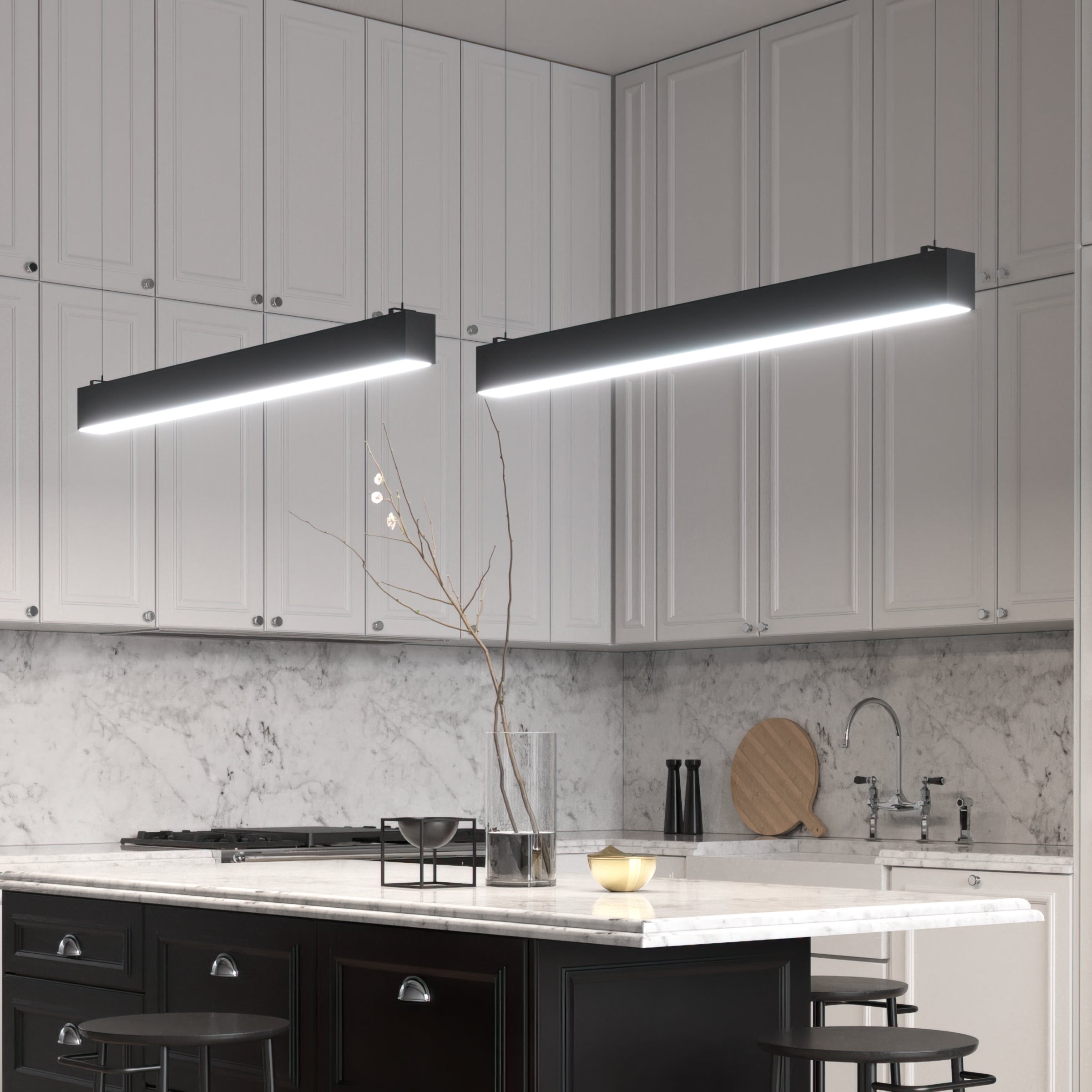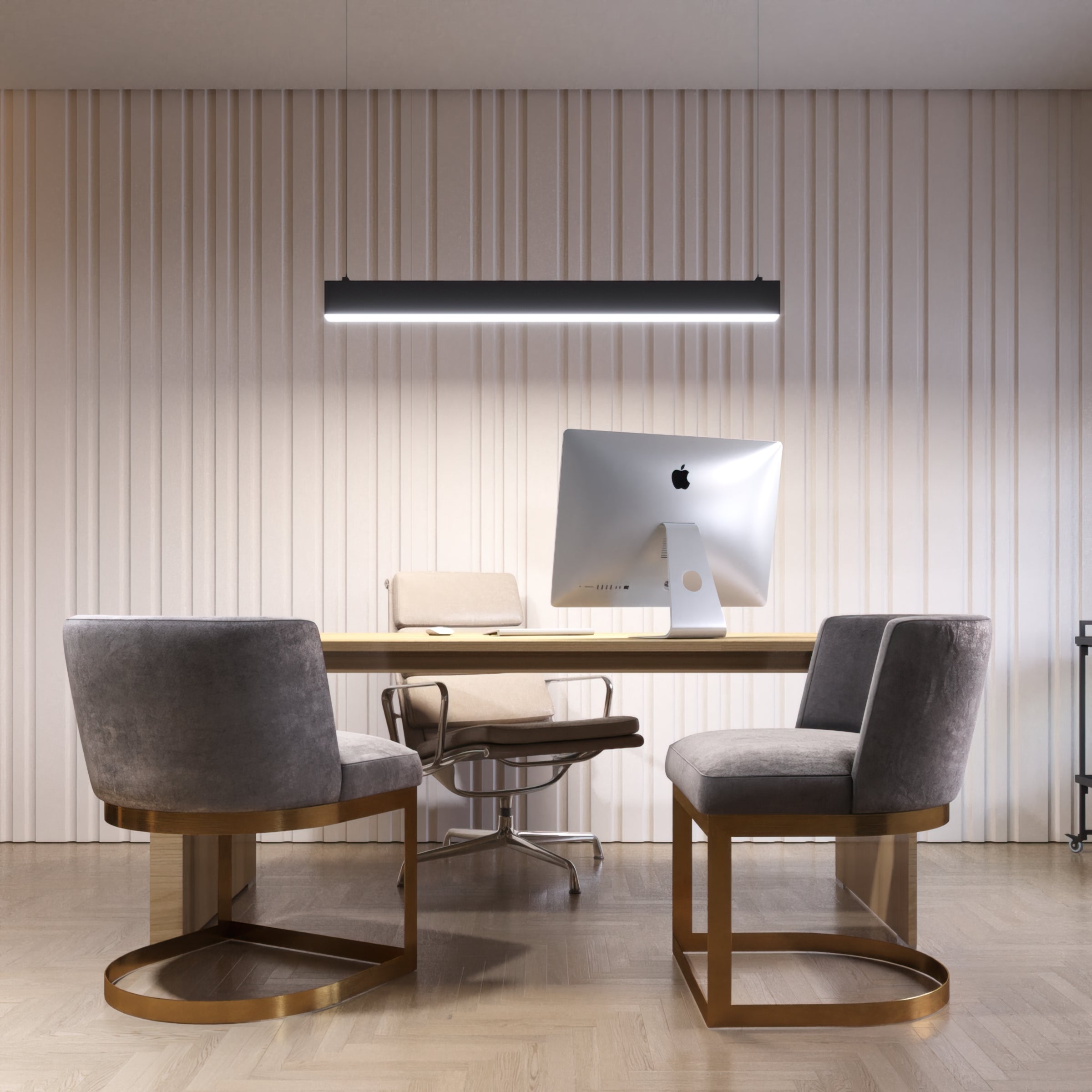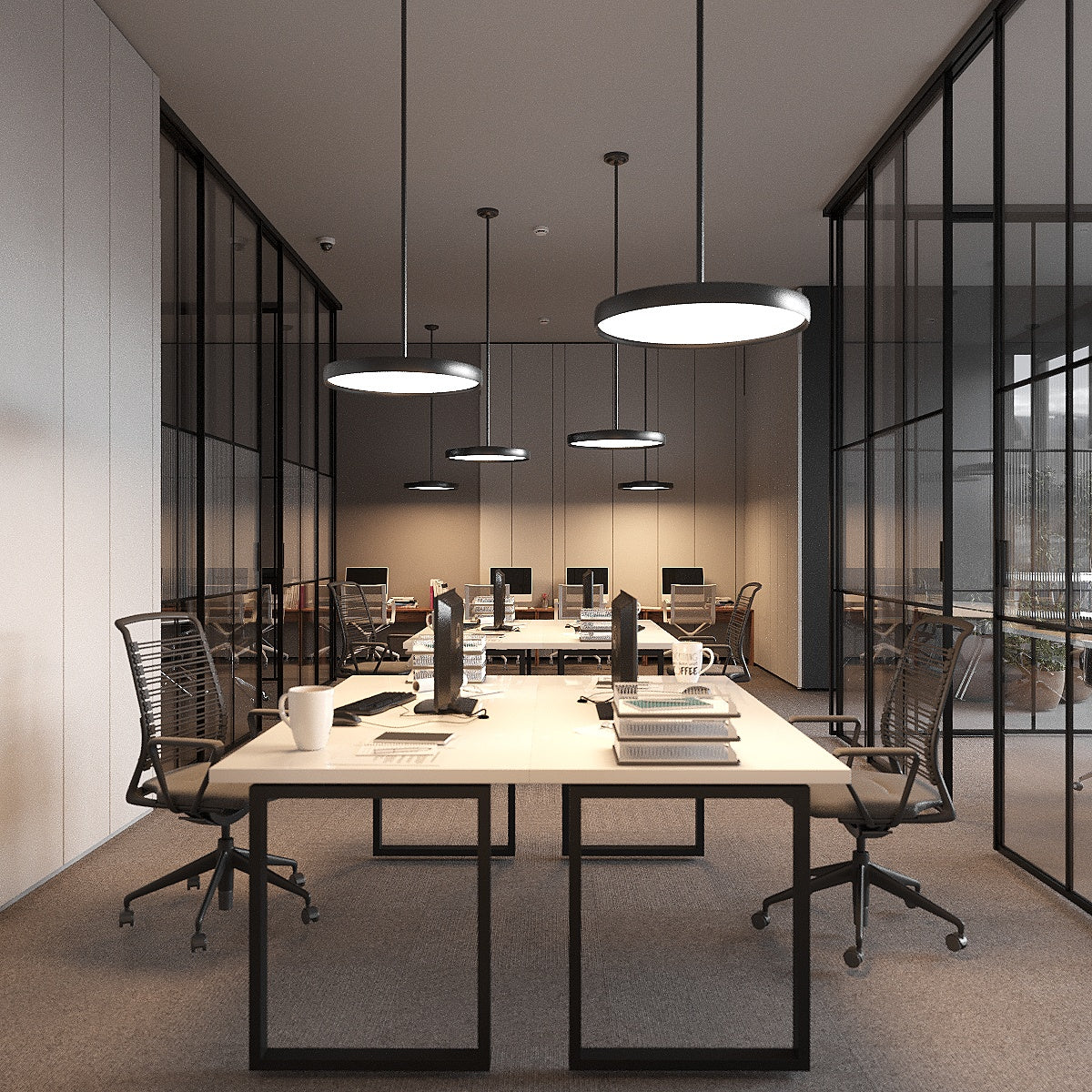All field must be filled positive numbers.
Lighting plays a crucial role in creating the atmosphere and functionality of any space. Whether setting up a new apartment, refreshing your home's interior, or working on an office project, the proper lighting can work wonders for your comfort and productivity. However, an important question arises: how many lumens do I need to properly illuminate a room?
To answer this, most designers and architects rely on two fundamental principles of lighting design: the qualitative (or aesthetic) aspect of light and the quantitative (or engineering) aspect of light. The qualitative aspect focuses on creating a cozy and pleasant atmosphere through lighting, highlighting decorative elements, and enhancing the beauty of the interior. On the other hand, the quantitative aspect deals with precisely calculating the necessary amount of light to ensure adequate brightness for daily activities.
The calculation of the total required lighting falls under the quantitative aspect and is carried out using parameters such as lumens. Lumens measure the light emitted by a source and are a crucial indicator for choosing the proper lighting for your space. With the rise of LED light fixtures, achieving the perfect illumination is easier than ever. LED lights are energy-efficient and provide a wide range of brightness levels to suit any room's needs. Using a lumens calculator for room size can help determine how many lumens you need.
Understanding how many lumens are needed for different types of rooms will help you create optimal conditions for work, relaxation, and entertainment, achieving the perfect balance between functionality and aesthetics. This guide will explore lumens, how to calculate lumens, and what to consider when selecting LED light fixtures. Following these recommendations, you can achieve ideal lighting that perfectly meets your needs and preferences.
Selecting the right lighting requires a high degree of precision. We provide our lumen calculator as a valuable tool for initial estimates. However, remember that these calculations are only approximate, and for a more comprehensive and expert evaluation, it’s advisable to seek the guidance of one of our specialists.
Lumens Calculator
The lumen calculator is a convenient tool for determining how many lumens you need to illuminate your space. It allows for precise calculations based on parameters such as room size, purpose, and Illumination level. This is particularly useful if you plan to install LED fixtures, as they can significantly reduce energy consumption compared to traditional light sources.
Here’s how it works:
- Select Room Type: Choose the room's purpose from the provided options, such as kitchen, bedroom, or office. Different types of spaces have varying lighting needs. For instance, a kitchen lumens calculator can help you determine the right amount of light for your kitchen.
- Select Unit of Measurement: To ensure the calculations are accurate for your region, choose the preferred unit of measurement, such as feet or meters.
- Input Room Dimensions: Enter the dimensions of your room—its length, width, and height. This information is essential for calculating the space's total volume and surface area. A lumens per square foot calculator can be particularly useful here.
- Specify Desired Light Level: Input the desired level of illumination tailored to the type of room and its specific use.
- Consider Wall Colors: Indicate the color of the walls in the room, as darker colors may require more lumens to achieve the same brightness level compared to lighter shades.
- Select Lighting Placement: You can choose where the lighting will be positioned, which can affect the distribution and intensity of the light.
Once you provide these details, the calculator calculates the number of lumens needed to achieve the desired lighting level. This tool offers a precise estimate, aiding you in selecting LED fixtures with the appropriate lumen output. For example, if you want to know how bright 1500 lumens is, this calculator can help.
Remember that while the lumen calculator is an excellent resource for initial assessments, the results are approximate. We recommend consulting with one of our experts for a thorough and professional evaluation.
How Does This LED Lighting Calculator Work?
This information was provided by Sergio Andriichenko, a lighting specialist with over 10 years of experience at LED Lights Direct.
Sergio Andriichenko
An expert in the design of new lighting concepts, explained how dimmable lighting is changing the approach to lighting.
Visit his Linkedin profile
Our lighting calculator is designed to help you choose the right amount of light for any space. It takes into account factors like room size, ceiling height, and how the space will be used. The recommendations are based on industry guidelines from the Illuminating Engineering Society (IES) and Energy Star standards.
For the most accurate results, the calculator suggests using tools like a lumens per square foot calculator or a foot candle calculator to meet recommended lighting levels. Matching the right number of lumens to your room size ensures you save energy while providing a comfortable visual environment.
Whether you're setting up lighting for a living room, office, or workspace, our calculator helps you find the right balance. You can also explore tools like a wattage calculator for LED lights to further customize your lighting needs and maximize efficiency.
Explaining Lumens and Watts in Lighting
Lumens
Lumens are a unit of measurement used to quantify the amount of visible light emitted by a light source. They measure the brightness or light output of a lamp or lighting fixture, not the energy consumed. For instance, a standard 100-watt incandescent light bulb produces around 1,500-1,700 lumens. This means 600 lumens from an LED light provide the same brightness level as 600 lumens from an incandescent bulb. Although LED lights produce similar lumens, they often have a higher Color Rendering Index (CRI), which reveals colors more accurately but does not necessarily provide more light.
Watts
Watts measure the amount of electrical power consumed by a light source or fixture. It is an indicator of energy use rather than light output. For example, a 60-watt incandescent lamp might produce about 800 lumens, whereas a 10-watt LED light can make the same amount of light but uses significantly less energy. Therefore, watts tell you how much power a light source uses, not how much light it provides.
Difference Between Lumens and Watts
The key distinction between lumens and watts is that lumens measure brightness while watts measure energy consumption. In the past, people often judged light intensity by wattage, assuming a higher wattage meant brighter light. However, with advancements in lighting technology, such as LEDs, a lower wattage can now produce the same or even greater light. This shift means that evaluating lighting needs based on lumens is more accurate and relevant than relying on wattage.
How Lumens Affect Lighting
Luminous efficacy is a crucial performance indicator for lighting technologies. It allows us to compare the energy efficiency of different light sources.
For example, legacy incandescent bulbs had a relatively low luminous efficacy of around 14 lumens per watt. In contrast, modern LED technologies typically achieve 70-110 lumens per watt, a remarkable sevenfold improvement in efficiency.
Lumens play a critical role in determining the brightness and effectiveness of lighting in a space. For instance, a room's lighting requirements depend on its size and purpose. More lumens are needed for task-oriented areas like kitchens and workspaces, while less is sufficient for ambient lighting in living rooms or bedrooms.
To better understand how different types of lighting compare in terms of luminous efficiency, refer to the table below, which shows the dependence of luminous efficiency of the kind of lamp. This table clearly compares how various light sources, such as incandescent, fluorescent, and LED lights, differ in their lumen output relative to their power consumption.
|
Luminous Efficacy |
|
|
Light Source |
Luminous Efficacy (Lumens/Watt) |
|
Incandescent |
12-16 |
|
Halogen |
14-22 |
|
CFL |
60–80 |
|
LED |
70-110 |
By understanding the relationship between lumens and watts, you can make more informed decisions about your lighting choices, ensuring you achieve the desired brightness while maintaining energy efficiency.
Wattage Equivalence
Wattage measures the electricity or energy a light bulb consumes to produce its lumen output. The lumen-to-watt ratio varies depending on the type of light sources, such as LED, fluorescent, halogen, or incandescent lights. For example, a 100-watt incandescent light can produce 1,500 lumens, while a 10-watt LED light can achieve the same brightness level. LED bulbs may claim to have a wattage equivalent to incandescent bulbs. Still, the actual ratios may differ slightly even among different LED products.
To illustrate these differences clearly, refer to the table below, which shows the lumen-to-watt ratios for different types of lighting fixtures. This chart will help you understand how various lighting technologies compare energy consumption and light output.
|
Lumens to Watts Conversion Chart |
||||
|
BULB TYPE |
||||
|
Lumens |
Incandescent Light |
Halogen |
CFL |
LED |
|
8000 |
580 Watts |
up to 450 Watts |
up to 115 Watts |
up to 90 Watts |
|
7000 |
500 Watts |
up to 390 Watts |
up to 100 Watts |
up to 80 Watts |
|
5000 |
350 Watts |
up to 280 Watts |
up to 70 Watts |
up to 60 Watts |
|
4000 |
300 Watts |
up to 220 Watts |
up to 60 Watts |
up to 45 Watts |
|
3000 |
200 Watts |
up to 175 Watts |
up to 42 Watts |
up to 35 Watts |
|
2600 |
150 Watts |
up to 150 Watts |
up to 35 Watts |
up to 27 Watts |
|
1600 |
100 Watts |
up to 72 Watts |
up to 24 Watts |
up to 20 Watts |
|
1100 |
75 Watts |
up to 53 Watts |
up to 18 Watts |
up to 16 Watts |
|
800 |
60 Watts |
up to 43 Watts |
up to 14 Watts |
up to 12 Watts |
|
450 |
40 Watts |
up to 29 Watts |
up to 11 Watts |
up to 9 Watts |
|
250 |
20 Watts |
up to 14 Watts |
up to 6 Watts |
up to 4 Watts |
|
RATED LIFE |
750 - 2,000 hours |
2,000 - 4,000 hours |
8,000 - 15,000 hours |
25,000 - 50,000 hours |
|
savings compared to incandescent lights |
X |
30% |
75% |
80-90% |
Understanding these differences is essential when choosing the right lighting for your needs. Here’s a brief overview of the main types of lighting technologies:
- Incandescent Light: Traditional incandescent bulbs produce light by heating a metal filament until it glows. While they offer a warm and inviting light, they are less energy-efficient than modern alternatives, consuming more power to produce the same brightness.
- Halogen: Halogen lights are a type of incandescent light that uses halogen gas to increase efficiency and brightness. They offer a bright, white light and are more energy-efficient than standard incandescent bulbs, but they still consume more energy than LEDs.
- CFL (Compact Fluorescent Lamp): CFLs use an electric current to excite mercury vapor, which produces ultraviolet light that is then converted into visible light by a phosphor coating. CFLs are more energy-efficient than incandescent and halogen lights, but they contain small amounts of mercury, which requires careful disposal.
- LED (Light Emitting Diode): LEDs are the most energy-efficient option, using semiconductor technology to produce light. They offer a wide range of color temperatures, are highly durable, and have a significantly longer lifespan than other types. LEDs consume less power while providing the same or even higher brightness levels. You can also read about 6 Benefits of LED Lighting for Your Health and Mood here
Choosing the right type of lighting involves balancing energy efficiency, light quality, and overall cost. By understanding the characteristics of each lighting technology, you can make informed decisions that meet your specific needs.

Foot-Candle in Lighting
It quantifies the level of illumination in a given area, helping you understand how well-lit a space is. It’s a way to quantify the level of illumination in a given area, helping you understand how well-lit a space is.
Simply put, one foot-candle is the amount of light that one candle emits onto a one-square-foot area from a distance of one foot. This measurement determines how much light is needed for different tasks and spaces.
How Foot-Candles Relate to Lumens and Watts
Lumens: Lumens measure the total amount of visible light emitted by a light source. More lumens mean more light. However, lumens alone don’t tell you how well that light is distributed across a space. That’s where foot-candles come in. For example, if a lamp emits 1,000 lumens, but it’s placed far from the surface you want to light, the foot-candle level on that surface may still be low.
Watts: Watts measure the amount of electricity a light source uses. It doesn’t directly measure how much light is produced but indicates how much energy is consumed. For instance, a 100-watt bulb might produce 1,500 lumens, but a 10-watt LED could produce the same amount of light, showing that LEDs are more efficient.
The picture below illustrates the difference between 1 foot-candle and 1 lux:


Understanding Foot-Candles with Examples
Explanations provided by our expert Sergio Andriichenko, a lighting specialist with over 10 years of experience at LED Lights Direct.
Imagine you’re setting up lighting for a home office. You’d want enough light to read documents comfortably without straining your eyes. If your office needs 50 foot-candles for comfortable reading, you need to calculate how many lumens are required to achieve that level of brightness in the space.
Calculate the Area: Measure the dimensions of your office. If it is 10 feet by 12 feet, the area is 120 square feet.
Determine Lumens Needed: Multiply the desired foot-candles (50) by the area (120 square feet). This gives you 6,000 lumens needed for your office.
Select Lighting: Choose light fixtures or bulbs that provide 6,000 lumens. Depending on their individual lumen output, you may need multiple fixtures or bulbs to reach this level.
Foot-Candles in Different Spaces
Living Room: You might need 10-20 foot-candles for general lighting.This helps create a comfortable, well-lit space without being too bright.
Kitchen: Task areas, like countertops, often need 70-80 foot-candles to ensure clear visibility while cooking and preparing food.
By understanding foot-candles, you can better plan your lighting setup to ensure you have the right amount of illumination where it’s needed most. This helps avoid over-lighting or under-lighting spaces, making your environment more comfortable and functional.
|
Foot-candle Requirements By the Room |
|
|
For Commercial Spaces |
|
|
Room Type |
Foot-candles |
|
Offices: Average Reading and Writing |
50-75 |
|
Offices: Hallways |
10-20 |
|
Offices: Rooms with Computers |
20-50 |
|
Hospitals: General Areas |
10-15 |
|
Hospitals: Labs / Treatment Rooms |
75-100 |
|
Schools |
30-100 |
|
Auditoriums / Assembly |
15-30 |
|
Libraries |
50-100 |
|
For Residential Spaces |
|
|
Room |
Foot-candles |
|
Living Room |
10-20 |
|
Dining Room |
30-40 |
|
Kitchen: Shared |
30-50 |
|
Kitchen: Stove |
70-80 |
|
Kitchen: Sink |
70-80 |
|
Bedroom |
10-20 |
|
Hallway |
10-20 |
|
Bathroom |
70-80 |
By grasping the recommended foot-candle standards for various room types, lighting experts can craft meticulous plans that perfectly harmonize illumination, functionality, and ambiance.
How Many Lumens in a Bulb?
The amount of light a bulb produces, measured in lumens, can vary significantly based on the type of lighting technology and wattage used.
Lumens measure the total amount of light a source emits, which is different from watts that measure the energy a bulb consumes, not its brightness.
To clarify: Watts describe energy usage, while Lumens describe the light output.
The table below shows how many lumens different types of lamps can produce depending on their wattage:
|
How many lumens in a bulb? |
||||
|
BULB TYPE |
||||
|
Incandescent Light |
Halogen |
CFL |
LED |
|
|
Ranges lumens per watt |
from 8 to 16 |
from 10 to 20 |
from 50 to 70 |
from 70 to 115 |
|
Typical lumens per watt ratio |
14 lumens/watt |
18 lumens/watt |
70 lumens/watt |
90 lumens/watt |
|
Bulb wattage |
lumens |
|||
|
15 watt bulb |
210 |
270 |
1050 |
1350 |
|
20 watt bulb |
280 |
360 |
1400 |
1800 |
|
25 watt bulb |
350 |
450 |
1750 |
2250 |
|
40 watt bulb |
560 |
720 |
2800 |
3600 |
|
60 watt bulb |
840 |
1080 |
4200 |
5400 |
|
75 watt bulb |
1050 |
1350 |
5250 |
6750 |
|
100 watt bulb |
1400 |
1800 |
7000 |
9000 |
|
150 watt bulb |
2100 |
2700 |
10500 |
13500 |
|
300 watt bulb |
4200 |
5400 |
21000 |
27000 |
|
400 watt bulb |
5600 |
7200 |
28000 |
36000 |
The Significance of Effective Lighting

Lighting can transform any space, creating an ambiance that impacts its functionality and overall feel.
Proper illumination can reshape our perceptions, set the mood, and enhance our well-being in ways we often underestimate.
Imagine high-quality, adjustable lighting meticulously chosen for each room—this is not just a luxury but a necessity for bringing out the best in any environment.
Take a look at these key insights from the Department of Energy case studies:
Evaluating Tunable LED Lighting in the Swedish Medical Behavioral Health Unit
Evaluating Tunable LED Lighting in Three Texas Classrooms
Lighting is crucial in regulating our internal circadian rhythms and energy levels.
When the quality or quantity of light is disrupted, it can negatively affect our physical and mental well-being. Therefore, it’s essential to carefully consider various lighting factors when designing spaces, whether they are residential or commercial.
Important considerations in lighting design include the type of light source, color temperature, beam angle, and most importantly, the total lumen output needed to properly illuminate the space. By optimizing these elements, lighting designers can create environments that feel cozy and intimate or spacious and energizing, depending on the room's intended use.

If you want to receive a high-quality project executed by a highly qualified lighting designer, leave a request on our website.
Identifying Room Needs and Utilizing Various Lighting Types

When designing lighting for your home, the right amount of light, or lumens, can vary a lot depending on what the room is used for.

Types of Lighting:
- Task Lighting
Task lighting is crucial in areas where specific activities take place, such as the kitchen and bathroom. It ensures clear visibility by reducing glare and shadows, making tasks like cooking or grooming easier without straining your eyes. Proper placement of recessed lights is essential, as it should align with the height of cabinets and furniture to maximize effectiveness.
- General/Ambient Lighting
General or ambient lighting provides a uniform level of illumination throughout a space, ensuring it is comfortable and safe for daily use. This type of lighting varies with the time of day and season and should be adjusted to maintain a balanced, glare-free environment.
- Accent Lighting
Accent lighting highlights particular elements, such as artwork or architectural features, drawing attention and adding visual interest to a room. Strategically positioning these lights can enhance the room's overall aesthetic and create a more inviting atmosphere.
A well-designed lighting scheme integrates these types to meet each room's specific needs and ambiance. By thoughtfully combining task, ambient, and accent lighting homeowners and designers can achieve functional, visually pleasing, and energy-efficient lighting solutions that elevate the overall living experience.

Grasping these detailed lighting needs is essential for crafting functional and visually striking spaces.
Living rooms and bedrooms often call for a more nuanced approach to lighting, blending various types and intensities to create a balanced atmosphere. Ambient overhead lighting is the foundation, providing general illumination for everyday activities and movement. In contrast, task lighting, positioned strategically, enhances focused tasks like reading or grooming without overpowering the space.
Accent lighting adds a decorative touch, emphasizing architectural features or artwork and enriching the ambiance.
When determining the total lumen output necessary for a room, it’s important to account for specific lighting needs. Areas intended for tasks like kitchen counters, dining tables, or bathroom mirrors generally need higher lumen levels to ensure proper lighting and facilitate detailed work.

In contrast, areas designed for relaxation, such as living rooms and bedrooms, typically require lower lumen levels per square foot. This approach preserves a cozy, inviting atmosphere without overly bright lighting.
By carefully balancing ambient, task, and accent lighting and adjusting the lumen output according to the room's intended use, lighting designers can create residential spaces that are not only aesthetically pleasing but also functional and energy-efficient.
Lighting is fundamental to the design and utility of any home. It serves various functions, from supporting daily activities to creating the desired mood. Understanding the different lighting types and their roles is essential for developing a well-rounded and effective lighting plan.
Are There Any Industry Guidelines or Standards for Recommended Lumens Per Square Foot?
The table below provides some examples of industry recommendations for how many lumens per square foot are suggested by different organizations.
- The Illuminating Engineering Society (IES)
- The American Lighting Association (ALA)
- The Energy Star program
| The Illuminating Engineering Society (IES) | The American Lighting Association | Energy Star | |
| recommended light levels are indicated in lumens/sq ft | |||
| Living rooms | 5-20 | 10-20 | |
| Bedrooms | 5-15 | ||
| Kitchens | 30-50 | ||
| Bathrooms | 15-30 | No specific recommendation | |
| Home office | 30-50 | No specific recommendation | |
As you can see from the table, the lighting recommendations from different organizations are mostly in agreement.
Here’s a brief overview of each organization mentioned in the table above:
The Illuminating Engineering Society (IES)
The Illuminating Engineering Society (IES) is a leading organization that has been shaping the art and science of lighting for over a century. They create lighting standards that cover everything from residential and commercial spaces to museums and medical facilities.
The IES offers general recommendations for how many lumens you need in different areas of your home. These guidelines take into account factors like the size of the room, the height of the ceiling, and how bright you want the space to be. They’re widely used by both homeowners and lighting designers to figure out how much LED or other lighting is needed to properly light various rooms.
These IES recommendations serve as widely recognized industry guidelines, assisting homeowners and lighting designers in determining the right amount of LED or other lighting to effectively illuminate various rooms in a home. The exact lumen requirements can differ depending on the specific characteristics of each space.
- Bringing together experts, researchers, and industry professionals.
- Developing and maintaining technical standards, guidelines, and recommended practices for a wide range of applications.
- Supporting a diverse membership of over 10,000 professionals from fields like architecture, engineering, academia, and manufacturing.
- Being accredited by the American National Standards Institute (ANSI) as a standards-developing organization.
- Offering educational programs, workshops, and conferences to keep lighting professionals up-to-date with the latest technologies and best practices.
In summary, the Illuminating Engineering Society stands as the leading professional society dedicated to improving lighting quality and efficiency through technical expertise, standards development, education, and research. Its guidelines and recommendations are highly respected in the lighting industry.
The American Lighting Association (ALA)
The American Lighting Association (ALA) is a leading trade group dedicated to the lighting industry in North America.
The ALA's main goal is to boost the growth and development of the lighting industry through advocacy, education, and setting industry standards.
- It acts as the voice of the lighting sector, representing manufacturers, retailers, designers, and other stakeholders.
- The ALA works to promote the use of high-quality, energy-efficient lighting solutions for both homes and businesses.
- The organization offers technical expertise, research, and resources on lighting design, technology, and applications.
- It creates best practices and guidelines for different lighting areas, including residential, commercial, outdoor, and specialty lighting.
- The ALA also pushes for policies and regulations that support the use of energy-efficient and innovative lighting products.
- With over 3,000 companies and individuals in its diverse membership, the ALA provides access to industry data, market insights, technical training, and opportunities to connect with other lighting professionals.
- The organization hosts an annual conference and trade show, offering a space for networking, showcasing products, and attending educational sessions.
- The ALA collaborates with industry partners and regulatory bodies to develop and promote lighting standards and guidelines.
In summary, the American Lighting Association is a key trade group focused on advancing the lighting industry by advocating for its needs, providing education, and developing industry standards and best practices.
The Energy Star Program
Energy Star is a joint initiative by the U.S. Environmental Protection Agency (EPA) and the U.S. Department of Energy (DOE) that promotes energy efficiency, including providing lumen density recommendations to encourage energy-efficient lighting design in homes.
Here’s what Energy Star is all about:
- Primary Mission: Helping consumers, businesses, and organizations save money and protect the environment through better energy efficiency.
- Environmental Impact: Aiming to reduce greenhouse gas emissions and other environmental effects by supporting energy-efficient products, homes, buildings, and practices.
- Certification and Labeling: Known for its product certification program, which highlights the most energy-efficient models across various product categories.
- Strict Guidelines: Products with the Energy Star label meet rigorous energy efficiency standards set by the EPA and DOE.
- Technical Specifications: Developing and maintaining guidelines that balance proper illumination with energy efficiency, considering factors like room size, typical activities, and lighting needs.
In summary, the Energy Star program is a well-recognized standard for identifying high-performance, cost-effective products that cut energy use without compromising on quality or features.


Tips for Choosing Lighting Fixtures with the Right Amount of Lumens
When selecting lighting fixtures, it’s essential to consider several key factors to ensure you get the right amount of lumens for your space and achieve optimal illumination. Here are some helpful tips:
Review Packaging and Technical Specifications
Check the packaging of your lighting fixtures for key details such as lumen output, wattage, and color temperature. Ensure that the fixtures provide the necessary lumen count for your room. Pay attention to the light output information, which indicates the total amount of light emitted by the fixture.
Use Foot-candles for Accurate Lighting Assessment
Foot-candles measure the level of illumination on a surface. Different rooms and tasks require varying amounts of foot-candles. To select the right lighting, consult tables with recommended foot-candle levels for various types of rooms. For instance, task areas like kitchens may need more foot-candles for effective task performance compared to bedrooms or living rooms.
Calculate Required Lumens with Our Lumen Calculator
To determine the number of lumens needed for your space, use our lumen calculator. This tool helps calculate the light output required based on room dimensions, ceiling height, and other factors. For example, a kitchen typically requires more lumens than a bedroom. Our lumen calculator considers these parameters and provides precise recommendations.
Compare Lumens and Wattage
Lumens and wattage are different metrics. Lumens measure light brightness, while wattage indicates energy consumption. When selecting fixtures, compare the lumen output needed with the wattage of the fixture. Modern LED lighting fixtures deliver more lumens with lower energy consumption compared to traditional light sources.
Evaluate Color Temperature
Color temperature, measured in Kelvin (K), affects how light is perceived. Warm white light (around 2700K) creates a cozy atmosphere, while neutral white (3500K-4100K) is suitable for work areas, and cool white (5000K and above) is better for tasks requiring high concentration, such as in offices.
Consider Brightness Levels for Different Tasks
Different rooms and tasks require varying brightness levels. For example, kitchens and work areas need brighter lighting compared to bedrooms or living rooms. Determine the lumen output required for specific tasks and choose fixtures that meet these needs.
Opt for LED Lighting Fixtures
LED fixtures are efficient and long-lasting, providing high light output with low energy consumption. They also have a long lifespan and low heat emissions. When choosing LED fixtures, ensure they provide the necessary lumens and the appropriate color temperature for your space.
Consider the Use of Dimmers
If you need adjustable brightness levels, select fixtures compatible with dimmers. This allows you to fine-tune the lighting to match your needs and mood.
Regularly Check and Update Lighting
Lighting needs and specifications can change over time. Periodically review your space’s lighting and update fixtures as needed to maintain optimal illumination and energy efficiency.
By following these tips and using our lumen calculator, you can choose lighting fixtures that deliver the right amount of lumens and meet your requirements.





